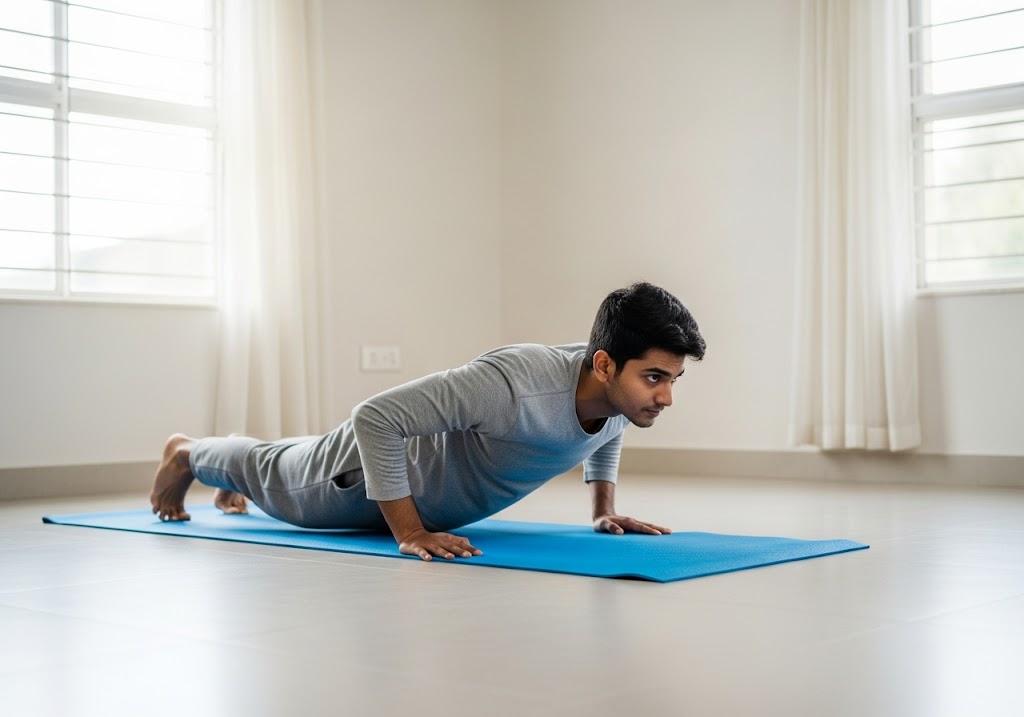How to do dumbbell bench press? The dumbbell bench press involves lying on a bench and pressing two dumbbells up from chest level to full arm extension while keeping proper form and control.
Learning how to do dumbbell bench press properly is one of the most important skills for building a strong, well-developed chest. This exercise works your chest muscles, shoulders, and arms all at the same time. Many people find the dumbbell version easier to learn than using a barbell. It also allows each arm to work independently, which helps build balanced strength.
Whether you are just starting out or want to improve your technique, this guide will teach you everything you need to know. We will cover the basic movement, different angles like incline and decline, common mistakes to avoid, and safety tips. The dumbbell bench press can help you build muscle, gain strength, and improve your overall fitness when done correctly.
Table of Contents
What is Dumbbell Bench Press?
The dumbbell bench press is a strength training exercise where you lie on a bench and push two separate weights (dumbbells) up from your chest. Unlike using a barbell, each arm works independently with its own weight. This makes the exercise more challenging for your stabilizing muscles.
This movement primarily targets your chest muscles (pectorals). It also works your front shoulder muscles and triceps on the back of your arms. The exercise requires you to control two separate weights, which helps improve your balance and coordination. Many people find this version more comfortable than barbell pressing because you can adjust the grip and movement path.
The beauty of learning how to do dumbbell bench press lies in its versatility. You can perform it on a flat bench, incline bench, or decline bench. Each angle targets slightly different parts of your chest muscles. This flexibility makes it an excellent choice for both beginners and advanced lifters who want to build a complete chest development program.
Discover the best back calisthenics exercises to improve posture, strength, and mobility—no equipment needed.
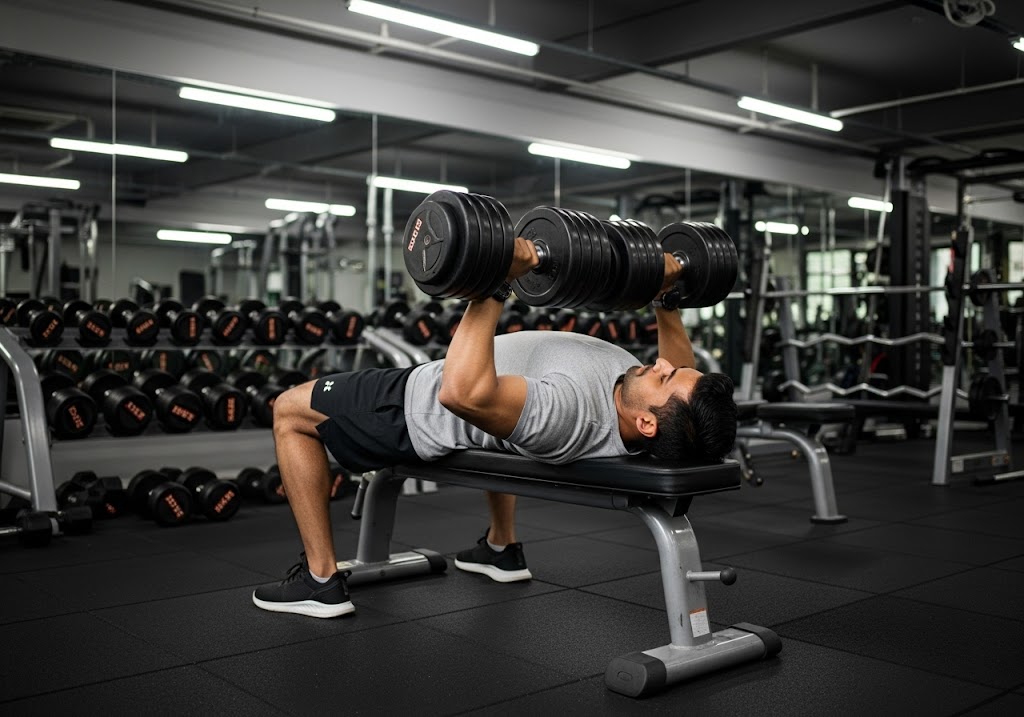
How to Do Dumbbell Bench Press? – Step by Step Plan
Mastering the step-by-step process for how to do dumbbell bench press requires attention to detail and proper sequencing. Each phase of the movement serves a specific purpose in maximizing effectiveness while maintaining safety. Follow these structured steps to build perfect technique from setup to completion.
| Step | Action | Key Points |
|---|---|---|
| 1 | Equipment Setup | Select appropriate weights, position bench |
| 2 | Starting Position | Sit with dumbbells on thighs, proper grip |
| 3 | Getting Into Position | Lie back while lifting weights to chest |
| 4 | Proper Form Setup | Shoulder blades back, elbows positioned |
| 5 | Pressing Movement | Push weights up in controlled arc |
| 6 | Lowering Phase | Control descent to chest level |
| 7 | Completing the Set | Safe dismount and weight placement |
Step 1: Equipment Setup and Preparation
Proper equipment setup forms the foundation of learning how to do dumbbell bench press effectively. Before touching any weights, ensure your bench is stable, appropriately positioned, and at the right height. Select dumbbells that match your current strength level rather than attempting to impress with heavy weights.
Getting into the right starting position is crucial for performing how to do dumbbell bench press safely and effectively. Start by selecting appropriate weights that you can control throughout the entire movement. Place the dumbbells on the floor beside your bench or have them ready on your legs.
Step 2: Establishing Starting Position
Creating a stable starting position determines the success of your entire how to do dumbbell bench press session. Your body position on the bench directly affects your ability to generate power, maintain control, and avoid injury throughout the movement pattern.
Sit on the edge of the bench with one dumbbell on each thigh, holding them with a firm grip. Your palms should face forward (away from your body). This starting position helps you safely get the weights into place. Keep your feet flat on the floor, shoulder-width apart, for stability throughout the movement.
Step 3: Transitioning Into Position
The transition from seated to lying position while controlling dumbbells requires coordination and proper technique. This phase of how to do dumbbell bench press often separates beginners from experienced lifters, as it requires smooth movement while maintaining weight control.
From your seated position with dumbbells on your thighs, carefully lie back while using your legs to help lift the weights up to your chest level. This technique prevents strain on your lower back and allows for controlled weight positioning at chest level.
Step 4: Perfect Form Setup
Establishing perfect form before beginning the pressing motion ensures optimal muscle activation and joint safety. This preparation phase of how to do dumbbell bench press sets the stage for effective repetitions while minimizing risk of injury or poor movement patterns.
Once lying down, position the dumbbells at chest level with your arms bent at roughly 90 degrees. Your elbows should point slightly downward, not straight out to the sides. This angle protects your shoulder joints from injury. Keep your shoulder blades pulled back and down, creating a stable platform for pressing.
Step 5: The Pressing Movement
The actual pressing phase represents the primary working portion of how to do dumbbell bench press. Proper execution requires coordinated arm movement, controlled breathing, and maintained body position throughout the full range of motion from chest to full arm extension.
Press both dumbbells up simultaneously, following a slight arc path as they come together above your chest. The weights should nearly touch at the top but don’t bang them together. Focus on squeezing your chest muscles while maintaining control of both dumbbells throughout the upward movement.
Step 6: Controlled Lowering Phase
The lowering phase provides significant muscle-building benefits when performed correctly during how to do dumbbell bench press. This eccentric portion of the movement should be controlled and deliberate, taking more time than the pressing phase to maximize muscle tension.
Lower the weights under control until you feel a gentle stretch in your chest muscles. This typically means your upper arms are parallel to the floor or slightly below. Avoid bouncing the weights off your chest, as this reduces effectiveness and increases injury risk.
Step 7: Safe Completion and Dismount
Properly finishing your set and safely returning weights to their starting position completes the how to do dumbbell bench press sequence. Many injuries occur during this phase due to fatigue, so maintaining focus and proper technique remains crucial even after completing your final repetition.
After completing your final repetition, bring your knees up while keeping the dumbbells close to your chest. Lower the weights to your thighs using your legs for assistance, then sit up and place the dumbbells safely on the floor or rack.
Check out our guide on how to lift heavier weights to improve your pressing strength progressively.
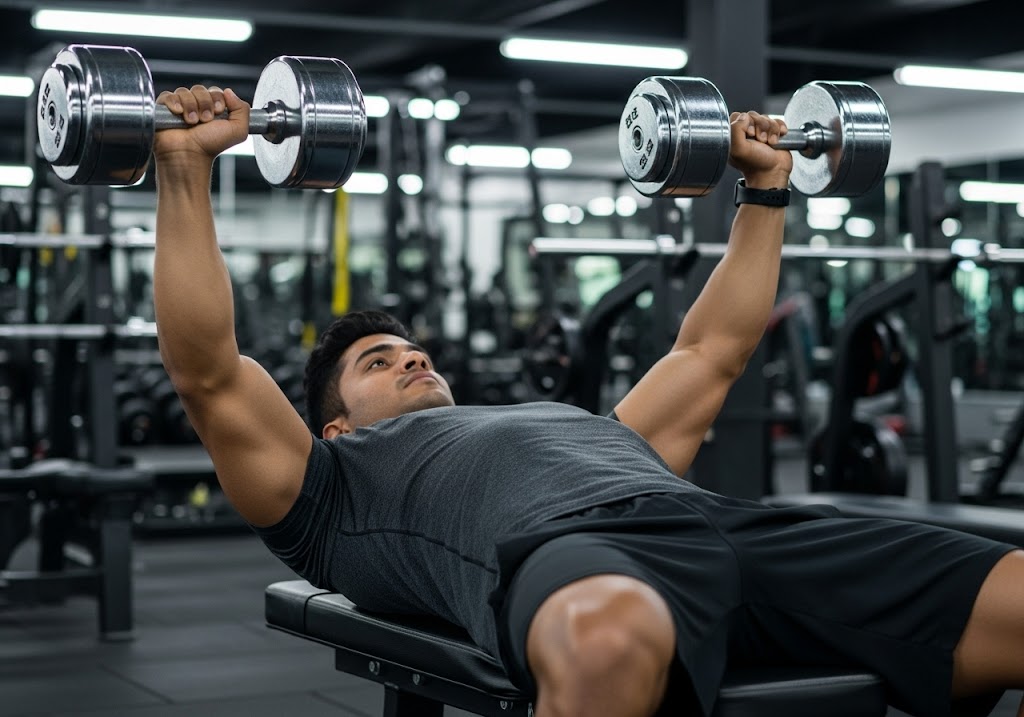
How to Do Incline Bench Press with Dumbbells?
Learning how to do incline bench press with dumbbells targets your upper chest muscles more effectively than flat pressing. This variation requires proper bench angle setup and modified technique to maximize upper pectoral activation while maintaining safety and control throughout the movement.
Kick off your fitness journey with our structured Calisthenics Workout Plan-the perfect balance of strength, mobility, and progression.
Incline Setup and Angle
Understanding how to do incline bench press with dumbbells adds an important variation to your chest training. Set your bench to an angle between 30 and 45 degrees. A 30-degree angle focuses more on your upper chest, while 45 degrees involves more shoulder muscles. Most people find 30-40 degrees ideal for targeting the upper chest effectively.
The setup process is similar to the flat version, but the angle changes how you position your body. Sit at the bottom of the inclined bench with dumbbells on your thighs. The incline makes it slightly more challenging to get into position, so take extra care when lying back. Your feet should remain flat on the floor for stability.
Here’s what makes incline different:
- Higher bench angle targets upper chest muscles
- Requires more shoulder stability than flat pressing
- May need lighter weights due to challenging angle
When you master how to do incline dumbbell bench press, you’ll notice better development in your upper chest area. This variation is excellent for creating a well-rounded chest appearance and improving overall pressing strength.
Master the most effective moves in this resistance band bicep workout to build strength and definition at home or anywhere.
How to Do Decline Dumbbell Bench Press?
The decline variation teaches you how to do decline dumbbell bench press to target your lower chest muscles. Set your bench to a decline angle of about 15-30 degrees. This position puts your head lower than your feet, which shifts emphasis to the lower portion of your chest muscles.
Setting up for decline pressing requires extra attention to safety. Secure your feet in the foot holds at the top of the bench before lying back with the dumbbells. The decline angle makes it harder to control the weights, so start with lighter loads than you’d use for flat pressing. Your body position should remain stable throughout the movement.
The pressing motion follows the same principles as flat and incline variations. Press the dumbbells up and slightly toward your feet, following the natural path of motion. Lower them under control until you feel a stretch in your lower chest. The decline angle provides a different feeling and targets muscles that flat pressing might miss.
For complete upper body development, combine this with calisthenics push workout routines.
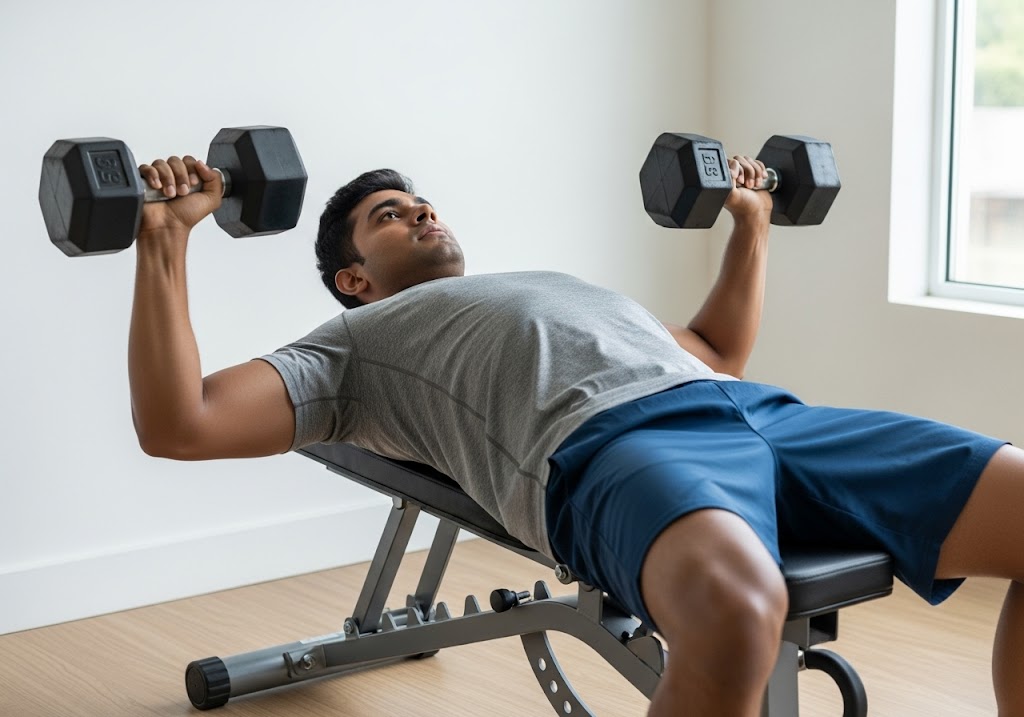
Benefits of Dumbbell Bench Press
Understanding the benefits of how to do dumbbell bench press helps motivate consistent training and proper technique development. These advantages extend beyond simple muscle building to include functional strength improvements, injury prevention, and balanced physical development patterns.
Learning how to do dumbbell bench press offers numerous advantages over other chest exercises:
- Independent Arm Movement – Your stronger side cannot compensate for your weaker side, preventing muscle imbalances that develop with barbells or machines
- Greater Range of Motion – Arms can move more naturally with deeper stretching compared to barbell pressing limitations
- Natural Movement Pattern – Feels more comfortable for shoulder joints with adjustable grip positions and movement paths
- Enhanced Stability Training – Controls two separate weights, challenging core muscles, shoulder stabilizers, and smaller support muscles
- Functional Strength Development – Stability challenge transfers to daily activities and other exercises even with lighter weights
- Balanced Muscle Development – Each arm must do equal work, promoting symmetrical strength and muscle growth
- Joint-Friendly Option – Allows natural joint movement without fixed barbell path restrictions
| Benefit | Description |
|---|---|
| Balanced Strength | Each arm works independently |
| Natural Movement | More comfortable joint positions |
| Greater Range | Deeper stretch and muscle activation |
| Stability Training | Improves stabilizing muscle strength |
Explore the pros and cons of both in our in-depth comparison: Push-ups vs Bench Press to choose what fits your fitness goals best.
Muscles Worked in Dumbbell Bench Press
Understanding which muscles work during how to do dumbbell bench press helps optimize your training approach and ensures balanced development. This comprehensive exercise activates multiple muscle groups simultaneously, making it highly efficient for upper body strength and muscle building goals. The primary muscle group targeted is your chest muscles (pectoralis major). These large muscles across your chest do most of the work during the pressing movement. Both the upper and lower portions of the chest activate, though flat pressing emphasizes the middle area most.
| Muscle Group | Role | Activation Level |
|---|---|---|
| Pectoralis Major | Primary mover for pressing motion | High |
| Anterior Deltoids | Assists pressing and stabilizes weight | Medium-High |
| Triceps Brachii | Extends arms during lockout phase | Medium |
| Core Muscles | Maintains body stability on bench | Medium |
| Upper Back | Stabilizes shoulder blades | Low-Medium |
| Leg Muscles | Provides stable platform | Low |
For additional upper body strength, explore our calisthenics for triceps exercises.
Common Mistakes to Avoid
Many people make predictable errors when learning how to do dumbbell bench press. The most common mistake is using weights that are too heavy. Heavy weights lead to poor form, reduced range of motion, and increased injury risk. Start with lighter weights that allow you to maintain perfect technique throughout all repetitions.
Another frequent error is allowing the elbows to flare out too wide. When your elbows point straight out to your sides, it puts unnecessary stress on your shoulder joints. Instead, keep your elbows at about a 45-degree angle from your body. This position is much safer and often feels more natural.
- Bouncing weights off the chest reduces effectiveness and increases injury risk
- Arching the back excessively can strain your lower spine
- Pressing too fast reduces muscle activation and control
Poor breathing technique also limits performance. Many people hold their breath during the entire set, which reduces strength and can cause dizziness. Instead, breathe out during the pressing phase and breathe in as you lower the weights. This breathing pattern helps maintain proper core stability.
Find out the science-backed truth in our guide: Do bodyweight exercises build muscle-and how to make them work for maximum gains.
Weight Selection and Progression
Choosing the right weight when learning how to do dumbbell bench press requires honest assessment of your current strength level. Start with weights that feel almost too easy for the first few sessions. This approach allows you to master the movement pattern before adding challenging loads. Most beginners should start with 10-15 kg dumbbells and progress gradually.
A good rule of thumb is to select a weight that allows you to complete 8-12 repetitions with good form, but the last 2-3 reps should feel challenging. If you can easily complete 15 repetitions, the weight is too light. If you struggle to complete 6 repetitions with good form, the weight is too heavy.
Progress by adding small amounts of weight each week or two. Most gyms have dumbbells that increase in 2.5 kg increments. Some people benefit from increasing repetitions first (from 8 to 12 reps) before adding weight. Listen to your body and progress at a sustainable pace rather than rushing to lift heavy weights.
| Experience Level | Starting Weight Range | Progression Rate |
|---|---|---|
| Beginner | 5-15 kg | 1-2.5 kg per week |
| Intermediate | 15-25 kg | 2.5 kg every 1-2 weeks |
| Advanced | 25+ kg | 2.5 kg every 2-4 weeks |
Combine your pressing workouts with warm up exercises for beginners to prepare your muscles properly.
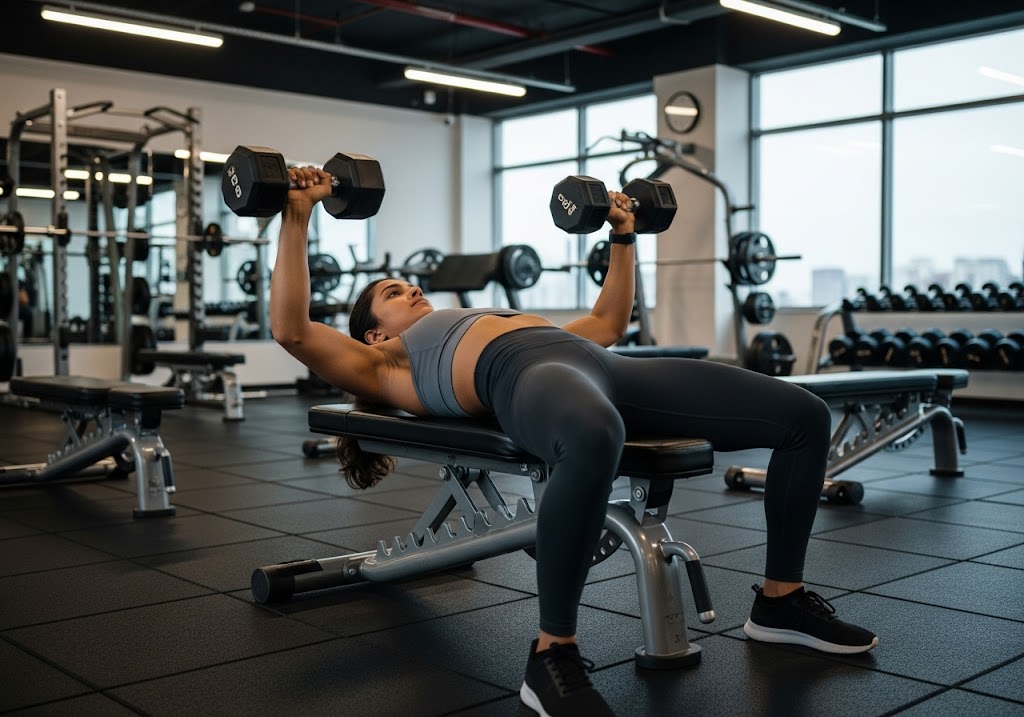
Safety Tips and Precautions
Prioritizing safety when learning how to do dumbbell bench press prevents injuries and ensures long-term training success. Following proper safety protocols protects your joints, muscles, and overall wellbeing while maximizing the effectiveness of each workout session.
Safety should always be your top priority when learning how to do dumbbell bench press:
- Use Appropriate Weights – Never attempt weights too heavy for your current strength level, as they increase risk of losing control
- Consider Using a Spotter – Have someone assist you with challenging weights, especially when approaching muscle failure
- Check Equipment Condition – Ensure bench stability and inspect dumbbells for secure handles and proper condition
- Clear Your Workspace – Remove obstacles around your bench that might interfere with movement or create hazards
- Warm Up Properly – Always start with lighter weights before progressing to your working sets
- Control Your Movement – Keep movements controlled throughout the entire range of motion, avoiding jerky or bouncing motions
- Listen to Your Body – Stop immediately if you feel any pain or unusual discomfort during the exercise
- Know Safe Exit Strategy – Learn how to safely lower dumbbells to your thighs and floor when you can no longer continue
Learn about how to speed up muscle strain recovery to handle any minor injuries properly.
Conclusion
Mastering how to do dumbbell bench press builds essential upper body strength while improving balance and coordination. Start with appropriate weights, focus on perfect form, and progress gradually. This versatile exercise targets chest, shoulders, and arms effectively when performed correctly and consistently.
Want to master the calisthenics handstand and take your skills to the next level? Whether you’re a beginner or pushing advanced skills, ISC – Indian School of Calisthenics offers expert guidance to help you master bodyweight training. Visit us at SRPF Ground, NH8, Goregaon (E), Mumbai – 400065. For class schedules, personalized coaching, or more details, call +91 77159 53218. Train smart, move better, and unlock your back strength with ISC.
How to Do Dumbbell Bench Press? – FAQs
How do I start learning the dumbbell bench press as a beginner?
Start with light weights (5-10 kg), focus on proper form, and practice the movement pattern before adding heavier loads.
What’s the difference between how to do dumbbell bench press and barbell bench press?
Dumbbells allow independent arm movement, greater range of motion, and help prevent muscle imbalances compared to barbell pressing.
How heavy should I go when learning how to do dumbbell bench press?
Choose weights that allow 8-12 repetitions with good form, where the last 2-3 reps feel challenging but manageable.
How often should I practice the dumbbell bench press?
Perform this exercise 2-3 times per week, allowing at least 48 hours of rest between sessions for muscle recovery.
What angle should I use when learning how to do incline bench press with dumbbells?
Set your bench between 30-45 degrees, with 30-40 degrees being optimal for targeting the upper chest muscles effectively.
Can I do the dumbbell bench press at home without a bench?
Yes, decline pressing typically requires lighter weights due to the challenging angle and reduced stability compared to flat pressing.
How do I know if my form is correct when doing the dumbbell bench press?
Your elbows should be at 45-degree angles, weights controlled throughout movement, and you should feel primary activation in your chest muscles.
What should I do if I feel shoulder pain during the dumbbell bench press?
Stop the exercise immediately, check your form, reduce weight, and consult a healthcare provider if pain persists.
How long does it take to master the dumbbell bench press technique?
Most people can learn basic technique in 2-4 weeks with consistent practice, though mastery continues to develop over months of training.

